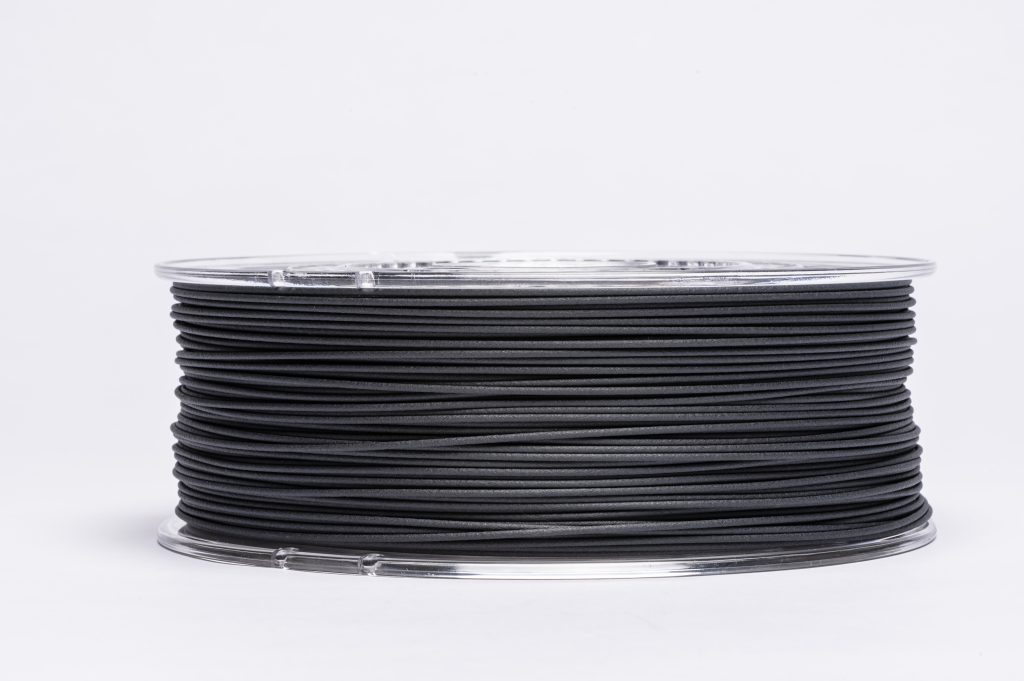German specialty chemicals company Evonik has developed carbon-fiber-reinforced PEEK filaments for 3D printed medical implants.
Named VESTAKEEP iC4612 3DF and VESTAKEEP iC4620 3DF, these filaments offer 12% and 20% carbon fiber content, respectively. These two options provide material choices based on the needed strength and flexibility for 3D printed implants like bone plates and reconstructive prostheses. According to Evonik, carbon fiber content provides strength, while PEEK adds flexibility and precision in fiber alignment during the 3D printing process.
“By introducing the world’s first carbon-fiber-reinforced PEEK filament for long-term medical implants, we continue to design biomaterials that open up new possibilities in today’s medical technology for patient-specific treatment,” says Marc Knebel, Head of Medical Systems at Evonik. “As passionate experts with decades of experience in polymer chemistry, we combine a unique set of competencies in materials science, manufacturing technologies and regulatory expertise to customers to accelerate time-to-market of new medical technologies for people’s lives beyond limits.”

Carbon-fiber reinforced peek filaments for medical applications
VESTAKEEP iC4612 3DF and VESTAKEEP iC4620 3DF combine high carbon-fiber strength with PEEK flexibility. Additional advantages include customizable carbon fiber alignment during 3D printing, suitability for patients with metal allergies, and an absence of x-ray artifacts. These 1.75 mm filaments are available on 500g and 1,000g spools and are compatible with standard FFF/FDM 3D printers for PEEK materials, with strict quality control for medical use.
In the context of long-term body contact applications, Evonik’s VESTAKEEP i4 3DF is used for implant-grade use, VESTAKEEP i4 3DF-T for testing and development, VESTAKEEP iC4800 3DF designed for osteoconductive implants. Additionally, two carbon-fiber reinforced options, VESTAKEEP iC4612 3DF (with 12% carbon fiber) and VESTAKEEP iC4620 3DF (with 20% carbon fiber) are tailored for enhanced strength in implant applications. As for short-term body contact applications, the VESTAKEEP Care M40 3DF filament is designed as a medical care grade.
In 2021, Evonik introduced VESTAKEEP Care M40 3DF filament, a body-safe filament for 30-day use. It’s compatible with standard high-temperature FDM 3D printers like those for PEEK. This filament expands possibilities for personalized patient care in prosthetics, surgical tools, and beyond, says the company.

Increasing demand for medical-grade 3D printing filaments
In April of this year, surgeries in the US featured a 3D printed spinal implant made from Evonik’s VESTAKEEP i4 3DF PEEK filament, created by Curiteva. This FDA-approved implant is the first 3D printed, fully interconnected porous PEEK implant for commercial use. The Inspire platform, manufactured by Curiteva, was used in these surgeries. Curiteva designed and built the exclusive patented 3D printer used in the implant’s production.
Austrian ceramic 3D printing company Lithoz and New York-based biomaterials specialist Himed announced a partnership for 3D printing of medical-grade bioceramics. Aiming to develop medical implants using biocompatible calcium phosphates this alliance aims to meet the growing demand for 3D printable bioceramic feedstocks. Lithoz’s LithaBone medical ceramics have garnered interest in the medical field and offer an alternative to metals for use in surgery, says the company. Lithoz’s LCM technology provides precision and design flexibility, making it a potential solution for lattice structures with specific osteoconductivity needs.
Who will win the 2023 3D Printing Industry Awards? Make your nominations now!
What does the future of 3D printing for the next ten years hold?
What engineering challenges will need to be tackled in the additive manufacturing sector in the coming decade?
To stay up to date with the latest 3D printing news, don’t forget to subscribe to the 3D Printing Industry newsletter or follow us on Twitter, or like our page on Facebook.
While you’re here, why not subscribe to our Youtube channel? Featuring discussion, debriefs, video shorts, and webinar replays.
Are you looking for a job in the additive manufacturing industry? Visit 3D Printing Jobs for a selection of roles in the industry.


